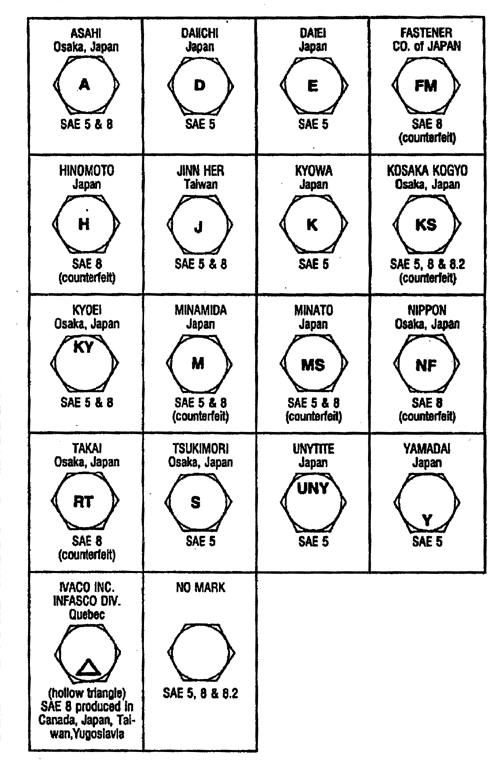|
|
|

|
|
|
|
The National Highway Traffic Safety Administration (NHTSA) started
an aggressive campaign to eliminate the use of counterfeit and
substandard bolts by vehicle and component manufacturers.
|
|
|
NHTSA's Office of Defects Investigation has compiled a list of
suspect fasteners which charts the maker's mark of each bolt for
easy identification (see chart on this page.) That list was distributed
to approximately 50 vehicles and component manufacturers who names were obtained
by customer lists seized by the U.S. Customs Service in shipments of counterfeit
and/or substandard Society of Automotive Engineers (SAE) Grade 5 and Grade 8 bolts.
|
|
|
Counterfeit and substandard bolts have been implicated in
a number of vehicle accidents and two recalls by heavy truck
manufacturers Petterbilt and Freightliner of Canada. Substandard
"KS" SAW Grade 8.2 bolts caused Peterbilt's 1988 recall of 556 tractors
for steering assembly failures while Freightliner of Canada recalled
364 tractors last year. KS bolts have been blamed for the death of at
least one truck driver.
|
|
|
CCJ has obtained a copy of a confidential letter of warning
written by NHTSA that urges against the use of bolts identified
in the list and cautions manufacturers never to purchase SEA
Grade 5 or SAE Grade 8 bolts lacking a maker's mark. Included
in the confidential mailing was a questionnaire to which
manufacturers were required to respond within 30 days.
|
|
|
"Failure to respond promptly and fully to this letter may be
construed as a violation," wrote Michael B. Browning, director
of NHTSA's Office of Defects Investigation-Enforcement Division.
|
|
|
Ten specific questions relating to bolt use and quality
of inspection policies are summarized here:
|
|
|
· What precautions, if any, are taken to protect
against installation of counterfeit and/or substandard
bolts in vehicles and/or vehicular components?
|
|
|
· If you have any listed bolt in inventory, who supplied it?
|
|
|
· If you have any listed bolt for vehicle or component
assembly, which applications, makes, models and production dates are involved.
|
|
|
· What documents regarding bolt related safety recalls,
customer complaints, warranty claims, accident reports
and/or lawsuits are on file? It was noted that copies
of all material must be submitted for analysis by NHTSA.
|
|
|
NHTSA currently is seeking to halt the use of SAE Grade 5
and Grade 8 bolts produced by certain companies. Both
grades are used widely on commercial trucks and trailers.
At the top of the agency's hit list are counterfeit SAE
Grade 5 and SAE Grade 8 bolts imported from sources in
Japan and elsewhere.
|
|
|
Genuine SAE Grade 8 bolts are expensive because they're
made of premium-priced alloy steel. Genuine SAE
Grade 5 bolts cost less because they're produced
from medium-carbon steel.
|
|
|
Counterfeit versions of those bolts are made from relatively
inexpensive, low-carbon martinsite steel, an easily
worked metal used in SAE Grade 5.2 bolts and SAE Grade 8.2 bolts.
|
|
|
In effect, compliance with SAE's J429 specification would result
in metric Grade 5.2 and 8.2 bolts being as durable as an
SAE Grade 5 and Grade 8, respectively. Unfortunately, some
counterfeiters are poor craftsmen, producing fakes which
often break under 20% smaller load and permanently deform
under a 30% smaller load than the genuine article, tests prove.
|
|
|
Congressional investigators warn that the risks posed by poorly-made
counterfeits must not be taken lightly. While these bolts
may not fail immediately when torqued, they may stretch.
That causes vehicle assemblies to loosen, thereby promoting
fatigue cracking and component failure. Stretched and
broken counterfeit SAE Grade 8 bolts have been discovered
by commercial vehicle operators in critical installations
such as 5th wheel mounts.
|
|
|
Certain imported bolts, while not counterfeit, often fail
to comply with SAW J429 quality standards for the SAE
grade indicated by their headmark. Installing dangerously-weak
bolts in critical installations requiring tough Grade 5's
and Grade 8's is equivalent to Russian roulette,
congressional investigators warn.
|
|
|
NHTSA is trying to be proactive about bad bolts. Rather
than waiting for a pattern of failure to be documented,
NHTSA lowered the boom on Neoplan USA Corporation's Bus
& Coach Division in Denver, Colorado.
|
|
|
Neoplan informed the NHTSA's associate administrator
for enforcement, George Parker, that 400 transit buses
made for RTD of Denver, Colo., and SORTA of Cincinnati,
OH, were likely to contain counterfeit and/or substandard
SAE Grade 5 and SAE Grade 8 bolts with marks including the "KS" logo.
|
|
|
Such bolts may have been used to an extent not determined,
for retaining steering assemblies, drive shafts and
engines, Neoplan admitted.
|
|
|
Accordingly, NHTSA leaned on the bus maker to
voluntarily replace all suspect bolts found in those 400 buses.
|
|
|
NHTSA's heavy-handed treatment of Neoplan is designed
to send a message to other vehicle makers. That is,
Uncle Sam will no longer tolerate the sometimes deadly
use of bad bolts in vehicular applications.
|
|
|
Part of the problem faced by vehicle makers is that bad bolts
often are accompanied by bogus certification of compliance
with SAE J429 or equivalent standards, NHTSA says.
|
|
|
For that reason, the agency strongly urges vehicle and
component makers to use a laboratory to spot-check
the compliance of newly received bolts with SAW specs;
deal only with reputable vendors of high-quality
fasteners; establish a formal program to save failed
fasteners for laboratory analysis.
|
|
The NHTSA also said that, at a later date, it
will turn its attention to automotive
applications of dangerously inferior metric bolts.
|

|
|
|